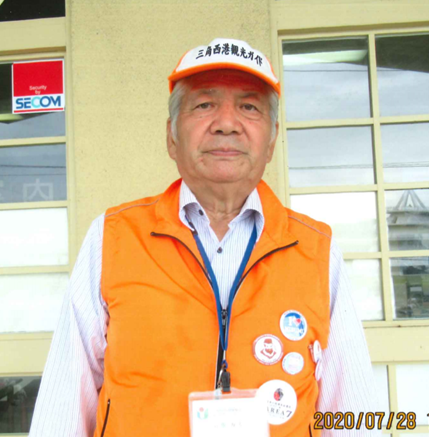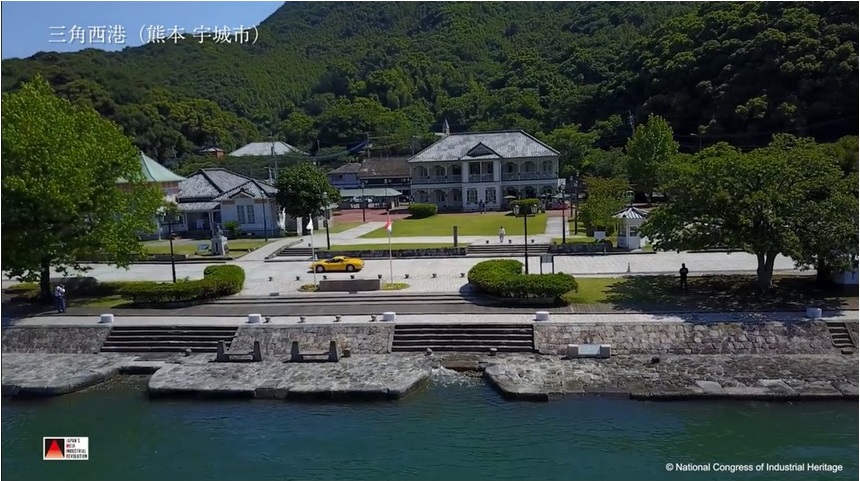PEOPLE
Chairman of the Tourist Guide Association of Misumi West Port

■We Were Told That “If We Do Not Have a Record of It, It Would Not Be Considered a World Heritage Site,” So We Began Our Research!
--Following this, in 1999, you established “the Society for Considering the Culture and Literature of Misumi West Port,” and you became the chairman of this group.
Saito: The aim of this group was to have Misumi West Port designated as a National Important Cultural Property. Thanks to the efforts of Professor Kiyoharu Horiuchi of Kumamoto University and others, in December 2002—the same year the Volunteer Guide Group was established—the National Council for Cultural Properties designated 765-meter-long stone-made wharf, three drainage channels, and four stone-built bridges of the West Port as National Important Cultural Property. At the time, there was some talk revolving around how it would be difficult to designate the site as a heritage site for the modernization of the Meiji period, so we were secretly relieved to hear that. Based on this, we applied to the Kyushu Governors’ Association to be on a tentative list of World Heritage Sites in 2006, which led to the present day.
--At that time, the fact that Misumi West Port was nominated as a new World Heritage Site must have caused a lot of excitement in the local area.
Saito: To tell you the truth, people did not really have much interest, at least in the private sector. Especially since it was the government that took the initiative in promoting the project. It was only after it was listed as a candidate on the domestic tentative list that it started to be taken more seriously and was executed in full-scale. We held symposia and events to liven up the local area and to build up the local momentum.

--I see. It was probably around that time that Mr. Saito, who was one of the local standard-bearers, met Koko Kato, executive director of the National Congress of Industrial Heritage. I heard that they suddenly got into a quarrel as they met (laugh out loud).
Saito: (Hahaha). In 2007, there was a ceremony to commemorate the 120th anniversary of the opening of Misumi West Port, and that is where I met with Ms. Koko Kato. She told me, “Well, although the West Port is a National Important Cultural Property, it would not be able to become a World Heritage Site unless there is a record of coal being shipped out,” and I thought, “Well, that is just great!” (laughs out loud).
That comment inspired me to go to the libraries of Arao City and Omuta City to look into documents and materials in regard to coal. I also went to the National Archives of Japan and went around used bookstores. Around that time, the Fukuoka Prefecture and Kumamoto Prefecture collaborated to release documents from the Mitsui Bunko. Then that is when they discovered that from 1890 to 1901, coal was exported from Misumi West Port to Shanghai, China, on ships called the Hideyoshi-maru and the Yoritomo-maru.
--That is how you came to put Executive Director Kato’s nose out of joint then, is it not (laughs out loud)?
Saito: No, no, no, it is not like that, I am just saying that everyone made an effort. Ms. Kato and I have continued to develop our friendship since then, and we are not a bad match (laughs). It was myself and Shigetaka Ito, Professor of Graduate School of Management at Kumamoto University, who guided the late Mr. Steuart Smith, Sir Neil Cossons, Mr. Michael Pearson, Mr. Barry Gamble, and four other foreign experts who came with Ms. Kato to conduct the survey. Ms. Kato and Mr. Kimiyasu Shimazu were the first to start this movement, and they worked passionately on it and motivated all the people involved, so I think the biggest contribution is Ms. Kato. I have nothing but gratitude for that.
--For such longtime activities of Mr. Saito, “Industrial Revolutionary Heritage of Meiji Japan: World Heritage Council to Promote Routes” presented a letter of appreciation at the 2018 Annual Meeting.
Saito: It was a great honor, and I was surprised. However, we have done what we needed to do. I have been involved with Misumi West Port for more than 30 years and have done what we needed to do, including guiding, creating all the manuals for that purpose, and continued to support comprehensive learning for local elementary schools since 2005. I believe that was what we have been recognized for. If we do not plant the seeds, we would not be able to pass them on to the next generation. That is the only reason we have continued to do what we have done.
Representative Director, National Congress of Industrial Heritage
(Honorary Advisor, Kyushu Railway Company (JR Kyushu)
Senior Researcher, Industrial Heritage Information Centre
Honorary Advisor, Nippon Mining Co., Ltd.
The Ambassador of Supporting Kamaishi Hometown
Former Director of Nagasaki City World Heritage Office
Former General Manager, Nagasaki Shipyard and Machinery Works, Mitsubishi Heavy Industries, Ltd.
Chairman, Fujisankei Group
Executive Managing Advisor, Fuji Television Network, Inc.
Executive Managing Advisor, Fuji Media Holdings, Inc.
Advisor, Federation of Japan Port and Airport Construction Association
(Ex. Chairman of Specialists Center of Port and Airport Engineering)
Mayor of Nagasaki City
Former Director of the Sano Tsunetami Memorial Museum (currently known as Sano Tsunetami and the Mietsu Naval Dock History Museum)
Director of NPO Association for Thinking about Satoyama
Director of National Congress of the Industrial Heritage
Honorary Chief Priest Toshinari Ueda
Former Mayor of Omuta City
Archaeologist and Heritage Conservation Specialist
A fellow of the Japan Federation of Engineering Societies
Team Member of the Industrial Project Team Office for the Promotion of World Heritage Listing under Cabinet Secretariat
Governor of Kagoshima Prefecture
Mayor of Hagi City
Mayor of Uki City, Kumamoto Prefecture
The Former Employee of Nippon Steel Corporation
An Associate Professor of the Faculty of Science and Engineering in Iwate University
Chairman of the Tourist Guide Association of Misumi West Port
President of Kuraya Narusawa Co., Ltd.
Chairman of Izunokuni City Tourism Association
Director and General Manager of Gunkanjima Concierge
Producer of the Gunkanjima Digital Museum
Owner at Tōge Chaya
Chairman: Mr. Hidenori Date
President: Mr. Masahiro Date
Proprietor, Houraikan Inn
Representative Director of Egawa Bunko non-profit incorporated foundation
The 42nd head of the Egawa Family
Democratic Party for the People (DPP) Representative for Nagasaki Prefecture
President of the NPO, Way to World Heritage Gunkanjima
Representative Director
MI Consulting Group
President of Watanabe Production Group and Honorary Chair of Watanabe Productions Co., Ltd.
Member of the House of Councillors
Governor
Kagoshima Prefecture
World Heritage Consultant
Director and Dean, The Kyushu-Asia Institute of Leadership
Representative Director, SUMIDA, Inc.
Journalist, founder of the Shimomura Mitsuko Ikikata Juku School
Representative, Rally Nippon
Chairman, Sites of Japan’s Meiji Industrial Revolution World Heritage Route Promotion Council Director, National Congress of Industrial Heritage
Representative Director, General Incorporated Foundation National Congress of Industrial Heritage (Advisor, Public Interest Incorporated Foundation Capital Markets Research Institute)
Mayor of Nagasaki City
Policy Director at Heritage Montreal
World Heritage Consultant
Executive Director of Kogakuin University
Heritage Architect and International Consultant
Head of Data Acquisition at The Glasgow School of Art’s School of Simulation and Visualisation
Head of Industrial Heritage, Historic Environment Scotland, Edinburgh
Scottish Ten Project Manager, Historic Environment Scotland, Edinburgh
Mayor of Izunokuni City, Shizuoka Prefecture
Pro-Provost and Chairman of Council of the Royal College of Art. Heritage advisor of Canal & River Trust for England and Wales.
Dean of Tokyo Rissho Junior College
Professor emeritus of Keio University
Mayor of Kitakyushu City
At the 39th session of the World Heritage Committee convened in Bonn, Germany, from June 28 to July 8, 2015, the decision was approved to inscribe the Sites of Japan’s Meiji Industrial Revolution on the World Heritage list.
At a celebratory party held to mark the occasion, some of the primary promoters of the project spoke of their joy in achieving their goal and of the trials and tribulations to getting there.
Director and Managing Executive Officer, Hanshin Expressway Company Limited
Member, Board of Directors, National Congress of Industrial Heritage
Vice-Governor of Shizuoka Prefecture
Mayor of Hagi City
Chairman, Tokyo Metro Co., Ltd.
Mayor of Omuta City
Deputy Director-General, Lifelong Learning Policy Bureau, MEXT
Former Counsellor, Cabinet Secretariat
Mayor of Kamaishi City
Member, Board of Directors, National Congress of Industrial Heritage Counselor, Shimadzu Limited
Chairman of the Consortium for the World Heritage Inscription of Modern Industrial Heritage (Kyushu-Yamaguchi) and governor of Kagoshima Prefecture (as of 2015)